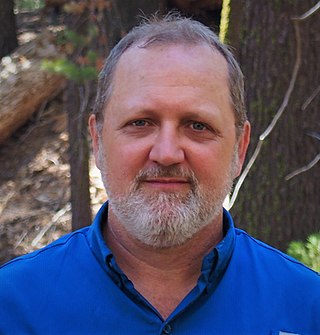Related Research Articles

Functional ecology is a branch of ecology that focuses on the roles, or functions, that species play in the community or ecosystem in which they occur. In this approach, physiological, anatomical, and life history characteristics of the species are emphasized. The term "function" is used to emphasize certain physiological processes rather than discrete properties, describe an organism's role in a trophic system, or illustrate the effects of natural selective processes on an organism. This sub-discipline of ecology represents the crossroads between ecological patterns and the processes and mechanisms that underlie them.

National Ecological Observatory Network (NEON) is a large facility program operated by Battelle Memorial Institute and funded by the National Science Foundation. In full operation since 2019, NEON gathers and provides long-term, standardized data on ecological responses of the biosphere to changes in land use and climate, and on feedback with the geosphere, hydrosphere, and atmosphere. NEON is a continental-scale research platform for understanding how and why our ecosystems are changing.
In ecology, the term productivity refers to the rate of generation of biomass in an ecosystem, usually expressed in units of mass per volume per unit of time, such as grams per square metre per day. The unit of mass can relate to dry matter or to the mass of generated carbon. The productivity of autotrophs, such as plants, is called primary productivity, while the productivity of heterotrophs, such as animals, is called secondary productivity.
Sarah Perin "Sally" Otto is a theoretical biologist, Canada Research Chair in Theoretical and Experimental Evolution, and is currently a Killam Professor at the University of British Columbia. From 2008-2016, she was the director of the Biodiversity Research Centre at the University of British Columbia. Otto was named a 2011 MacArthur Fellow. In 2015 the American Society of Naturalists gave her the Sewall Wright Award for fundamental contributions to the unification of biology. In 2021, she was awarded the Darwin–Wallace Medal for contributing major advances to the mathematical theory of evolution.

Diana Harrison Wall was an American environmental scientist and soil ecologist. She was the founding director of the School of Global Environmental Sustainability, a distinguished biology professor, and senior research scientist at the Natural Resource Ecology Laboratory at Colorado State University. Wall investigated ecosystem processes, soil biodiversity and ecosystem services. Her research focused on the Antarctic McMurdo Dry Valleys and its Wall Valley was named after her. Wall was a globally recognized leader and speaker on life in Antarctica and climate change.
Erika S. Zavaleta is an American professor of ecology and evolutionary biology at the University of California, Santa Cruz. Zavaleta is recognized for her research focusing on topics including plant community ecology, conservation practices for terrestrial ecosystems, and impacts of community dynamics on ecosystem functions.
Emily Stanley is an American professor of limnology at the University of Wisconsin–Madison. She was named a 2018 Ecological Society of America Fellow and her research focuses on the ecology of freshwater ecosystems.
Sarah E. Gergel is an American ecologist and professor in the Department of Forest and Conservation Sciences at the University of British Columbia (UBC), Canada. She is a landscape ecologist, known for her research linking landscapes and rivers, and her role in enhancing training in the practice of landscape ecology.
Amy D. Rosemond is an American aquatic ecosystem ecologist, biogeochemist, and Distinguished Research Professor at the Odum School of Ecology at the University of Georgia. Rosemond studies how global change affects freshwater ecosystems, including effects of watershed urbanization, nutrient pollution, and changes in biodiversity on ecosystem function. She was elected an Ecological Society of America fellow in 2018, and served as president of the Society for Freshwater Science from 2019-2020.
Jeannine Cavender-Bares is a Distinguished McKnight University Professor at the University of Minnesota in the Department of Ecology, Evolution & Behavior. Her research integrates evolutionary biology, ecology, and physiology by studying the functional traits of plants, with a particular focus on oaks.
Elena M. Bennett is an American ecosystem ecologist specializing in studying the interactions of ecosystem services on landscape. She is currently a Professor and the Canada Research Chair in Sustainability Science at McGill University. She was inducted to the Royal Society of Canada’s College of New Scholars, Artists, and Scientists in 2017. She was elected a member of the National Academy of Sciences in 2022 and became a Guggenheim Fellow in the same year.

Bradley Cardinale is an American ecologist, conservation biologist, academic and researcher. He is Head of the Department of Ecosystem Science and Management and Penn State University.
Leah R. Gerber is a conservation biologist and environmental scientist most known for her contributions to the field of biodiversity conservation. She has conducted research on population ecology, conservation decision-making, and the application of innovative quantitative methods in conservation biology.
Catherine Mann Pringle is a distinguished research professor at the Odum School of Ecology at the University of Georgia. She studies aquatic ecosystems and conservation. Pringle has previously served as president of the Society for Freshwater Science. She is a Fellow of the American Association for the Advancement of Science and the Ecological Society of America.

Shahid Naeem is an ecologist and conservation biologist and is a Lenfest Distinguished professor and chair in the Department of Ecology, Evolution, and Environmental Biology at Columbia University. Naeem is the author of Biodiversity, Ecosystem Functioning, and Human Well-Being, and has published over 100 scientific articles.
Julia Kathleen Baum is a Canadian marine biologist. In 2017, she was named to the Royal Society of Canada's College of New Scholars, Artists, and Scientists. She was awarded a Pew Fellowship in Marine Conservation in 2017 and an EWR Steacie Fellowship in 2018.

Jessica Hua is an associate professor in the Department of Biological Sciences at Binghamton University, NY. In addition Hua is the Director for the Center for Integrated Watershed Studies at Binghamton University which focuses on understanding watersheds and the human influences on them through research. She is a herpetologist and oversees her own lab, The Hua Lab, where they focus on ecological interactions, evolutionary processes and ecological-evolutionary feedbacks. Hua's background has led to her appreciation of education with coming from a refugee family who "epitomizes the concept of the American Dream". Her research aims to help others gain opportunities while also establishing a lab that is inclusive and diverse. Hua also enjoys a variety of sports and plays disc golf professionally since 2016.
Stacy Philpott is an American ecologist who is a professor at the University of California, Santa Cruz. Her research considers agroecology and the conservation of biodiversity. She was elected a Fellow of the Ecological Society of America in 2021.

Karin M. Kettenring is an American plant ecologist based in Logan, Utah. Her research focuses primarily on aspects of wetland plant ecology, including invasive plant ecology and management, native wetland seeds and seedlings, and wetland restoration. Kettenring worked in several labs and research stations across the United States before obtaining a faculty position at Utah State University as a professor of wetland ecology. Her most cited publication, “Lessons learned from invasive plant control experiments: a systematic review and meta-analysis,” looks at the literature discussing invasives species control experiments and how to ensure that research practices are most effective.
Diana F. Tomback is an American ecologist and an academic. She is a professor of Integrative Biology at the University of Colorado Denver as well as the policy and outreach coordinator at the Whitebark Pine Ecosystem Foundation, a non-profit organization.
References
- 1 2 3 4 5 Crump, Martha L.; Lannoo, Michael J. (August 23, 2022). Women in Field Biology: A Journey into Nature. CRC Press. pp. 182–183. ISBN 9781000631166.
- ↑ Moore, David S. (2010). The Basic Practice of Statistics. W. H. Freeman and Company. p. 554. ISBN 9781429224260.
- ↑ Cadotte, Marc W.; Davies, Jonathan (2016). Phylogenies in Ecology: A Guide to Concepts and Methods. Princeton University Press. pp. 146, 165–166. ISBN 9781400881192.
- ↑ Fukami, Tadashi (January 2018). "Messy Communities: The Arising Researcher". Bulletin of the Ecological Society of America . 99 (1): 58–59. doi: 10.1002/bes2.1376 . Retrieved May 3, 2024– via ProQuest.
- ↑ Newman, Jonathan A.; Varner, Gary; Linquist, Stefan (October 5, 2017). Defending Biodiversity: Environmental Science and Ethics. Cambridge University Press. pp. 80–81. ISBN 9780521768863.
- ↑ Toadvine, Ted (2024). The Memory of the World: Deep Time, Animality, and Eschatology. University of Minnesota Press. p. 156. ISBN 9781452970967.
- ↑ Skirble, Rosanne (June 11, 2012). "Ecologists Call for Action on Biodiversity Loss". Voice of America . Retrieved May 2, 2024.
- ↑ "Researchers find threat from biodiversity loss equals climate change threat". Whitehorse Daily Star . June 8, 2012. Retrieved May 3, 2024– via Newspapers.com.
- ↑ Charlebois, Brieanna (June 27, 2022). "Some plant and animal recovery a year after heat dome". Canada's National Observer . Retrieved May 2, 2024.
- ↑ Crawford, Tiffany (June 4, 2010). "UBC researcher honoured for study on the feats of our feathered friends". The Vancouver Sun . Retrieved May 3, 2024– via Newspapers.com.
- ↑ Luke, Paul (May 11, 2015). "Raising twins and triplets: Everything is a challenge". Times Colonist . Retrieved May 2, 2024.
- ↑ "Twins' parents seek double EI benefits". CBC.ca . June 21, 2010. Retrieved May 2, 2024.
- ↑ "Two Moms, Two Babies, One Family". WestCoast Families . May 4, 2011. pp. 27–28. Retrieved May 2, 2024.